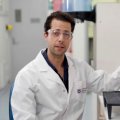A physics iLab experiment at The University of Queensland has just welcomed its 8000th student, carrying the University’s name into the science classrooms of North America.
Since 2007, the experiment, designed and built at UQ, has been teaching high school students in Illinois about the spread of radiation and the inverse square law.
However, unlike conventional experiments, the striking difference is that the equipment used in this experiment is housed and runs from the famous Parnell Building at UQ’s St Lucia campus, with the American students accessing it over the Internet.
“The iLab radiation experiment is based on radioactivity experiments that were originally taught in two of our UQ undergraduate physics courses,” said Dr Gary Tuck of the School of Mathematics and Physics, who had assisted in constructing the iLab experiment.
The iLab experiment examines the intensity of radiation over distance, thereby demonstrating the effects of the inverse square law.
Students log in to ilabcentral.org, select the radiation experiment, and run the experiment, testing different values for the dispersal of radiation as distance increases from the radioactive Strontium-90 source.
They then receive data for analysis in the form of a .csv file.
“One of the units of this experiment enables the statistical nature of the decay of radioactive elements to be observed and also allows us to test the validity of the inverse square law for radioactive emissions,” said Dr Tuck.
“Another unit which is under development also allows these two tests and extends the behaviour of radioactive emissions to examine the absorption qualitatively of different materials by alpha, beta and gamma radiation.”
Associate Director of UQ's Centre for Educational Innovation and Technology (CEIT) Dr Mark Schulz has led the experiment, with UQ's Len Payne designing the control system, and the UQ School of Information Technology and Electrical Engineering workshop built the physical mechanism.
With his background in physics, Dr Tuck assisted in providing interpretations of results, as well as equipment components such as the radioactive Strontium-90 source for the experiment.
At the same time, colleagues at Northwestern University in Chicago organised groups of high school teachers to create an online learning framework incorporating the experiment for their students.
Funding for the radiation experiment was organized through the Massachusetts Institute of Technology by Professor Phil Long, Director of CEIT, from an NSF grant CI-TEAM Implementation Project - The iLab Network: Broadening Access to Hands-on STEM Learning via Remote Online Laboratories.
Next time you pass the Parnell Building in UQ, remember that the experiment is not only at St Lucia, but virtually overseas as well. Check out the introductory video at http://ilabcentral.org/10.php.
Story supplied by Professor Emeritus Roland Sussex OAM, Research Fellow, Centre for Educational Innovation and Technology, with additional input from the UQ School of Mathematics and Physics.
Media: Dr Gary Tuck (07 3365 3411, tuck@physics.uq.edu.au)
General Inquires: CEIT – Dr Mark Schulz, Assoc. Dir., Centre for Educational Innovation & Technology (07 3365 9132, m.schulz@uq.edu.au) or School of Mathematics and Physics Communications & Marketing Officer Aarti Kapoor (07 3346 9935, a.kapoor@uq.edu.au)
.jpg)











